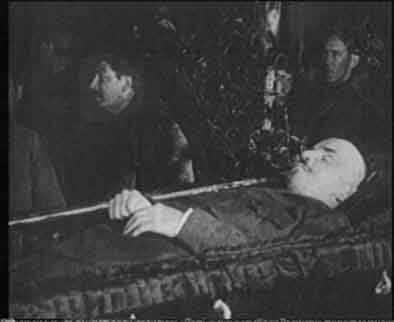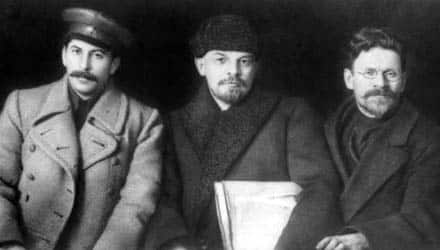The Great Terror that began with Kirov’s death had many far-reaching results. One of the main results was that Stalin’s political dominance was reinforced a thousand fold, but there were other consequences of the purges, both social and economic. These consequences changed the lives of ordinary Russian people to a huge extent – food shortages and killings became commonplace. However, I would argue that despite these other outcomes of the Great terror, the most important result of the 1934-38 repression was the strengthening of Stalin’s political dominance.
The political impact of the Great Terror was colossal. It publicly established the guilt and corruption of those who had once opposed Stalin, which cemented the people’s belief in Stalin, and provided scapegoats for all that went wrong under Stalin’s regime, so that Stalin was never to blame.
The three Moscow trial ‘proved’ that Stalin’s opponents were in the wrong: Zinoviev, Kamenev and Bukharin, who would have been rallying points for any resistance to Stalin’s regime, were ‘exposed’ as traitors to Russia – thus, resistance and followers of any leader other than Stalin were effectively destroyed.
The show trials were also an effective method for diverting people’s attention away from the hardships of life under Communist rule. Stalin encouraged workers to hold their bosses to account for anything that went wrong in the workplace, which meant that government employees, Party officials and factory managers were all held to account for the people’s frustrations.
In Kazan, for example, Communist officials were publicly tried for misusing government funds for a luxurious lifestyle. No crime had actually been committed, as membership of the Communist Party meant an entitlement to luxury, but local people felt that their accusations had been justified and vented their anger.
However, the impact of the Great Terror was not merely in politics: the social impact of the repression was also immense. Purges were commonplace; those in the army or the Party were likely to be shot or exiled, and in 1937-38 the ‘Yezhov bloodbath’ meant that 10% of adult males were either executed or sent to gulags. Specific nationalities were targeted; Poles, Romanians, Latvians and Jews were persecuted.
Families were terrorised; wives were often arrested along with their husbands, Party officials. If the wives were allowed to stay free they were left head of a broken family, trying to get their husbands out of prison and way from a possible death sentence or gulag. Children of purged Party officials were expelled from university or exposed to ritual humiliations in schools by their teachers and classmates; they were also expected to publicly disown the relative that had been purged in a formal renunciation that became part of daily life.
As well as the cost of family life, the Great terror had a marked effect on factory management. In each case, the existing elite was eradicated to be replaced by a new group of leaders more loyal to the Stalinist regime. Workers were encouraged to scrutinise their leaders for any possible defection from Stalinist ideals and to accuse the, publicly in show trials. As a result, the existing management of the Soviet industry were scapegoated for problems and sacked or turned over to the NKVD.
Local Party organization also underwent a huge change due to the Great Terror of 1934-38. In 1937 there was a huge purge of existing Communist Party membership because of the spring elections, Stalin issued no directions as to who should be elected and who not, so it was left to the terrified Party members to analyze the behaviour of the candidates for high office.
Junior members of the Party took on the role of the NKVD, interrogating those who sought election and unmasking many as ‘enemies of the people’. In this way, the spring elections, combined with repression, were used to purge Communists in positions of authority. The same principle was applied to candidates for the leaders of Russia’s trade unions.
Because of the widespread terror and persecution, forged identities became standard practice for many. Kulaks, priests, Nepmen and former Russian nobility reinvented themselves as workers, inventing entire family trees or marrying into genuine working families, and forged identity papers were available throughout Russia. The social impacts of the Great Terror of 1934-38 were that leadership was changing hands hard and fast, families were torn apart, thousands were killed and many had to reinvent themselves to avoid persecution or execution.
The last significant result of the 1934-38 repression was the disastrous Russian economy. Communist Party members had to lie about economic facts to give the impression that the government had met its targets, so they could avoid arrest and execution.
This meant that it was impossible to plan effectively for the economy because the truth was often blatantly distorted. Purges within Gosplan also eliminated many of the most experienced economic planners, and at a local level, many competent industrial managers were killed.
These two factors combined meant that economic growth slowed drastically: the third five-year plan was a failure due to the Great Terror’s purging of the most skilled managers, planners and workers.
For example, in the Donbas region, coal production accounted for 77% of Russia’s total coal production, but due to extensive purges in management, while production had doubled twice between 1928 and 1936, barely rose during the Great Terror.
In conclusion, while Russia’s economic and social infrastructures were damaged hugely due to the repression of 1934-38, Stalin emerged from the Great Terror politically stronger than ever before.
The Terror had removed any potential threats within the military, economic and political leadership of Russia as well as providing scapegoats to explain the gap between Stalin’s vision of socialist Russia and the everyday reality of hardship, cruelty and economic failure.
Therefore, while socially and economically Russia was floundering, Stalin kept a tight rein on politics, which meant that ultimately Stalin could keep on with his policies and enforcing terror and cruelty on the Russian people. The most important result of the repression of 1934-38 repression was the strengthening of Stalin’s political dominance, despite the Terror’s other social and economical consequences.


